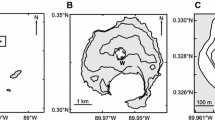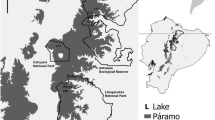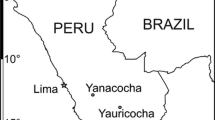Abstract
High Arctic lakes are among the most sensitive ecosystems and climate change strongly affects their physical properties, especially water temperature, and mixing processes. To study the effect of recent climate change on such a lake in the Arctic environment, we measured water chemistry and temperature from 2005 to 2010 in Kongressvatn, a crenogenic meromictic lake in Spitsbergen (Svalbard). In addition, we monitored water column temperatures during two consecutive years and compared them to regional air temperature data and physicochemical lake data from 1962 and 1968, two relatively cold years. Summer surface water temperature was highly correlated to air temperature, and both have increased by approximately 2°C since 1962. Temperature monitoring during 2 years showed that the warm summer of 2007 resulted in increased water temperatures even in the stratified, denser hypolimnion. Our water chemistry measurements showed that the chemocline position in 2005–2010 was ca 12 m deeper than in 1962–1968, and a second, weaker, chemocline appeared at metalimnetic depths of 7–15 m. During the study period, the water level decreased by 4 m, and this change accelerated between 2008 and 2010. Our data support the hypothesis that water temperatures and stratification patterns are changing rapidly with air temperature, but changes in the catchment, such as glacial retreat and permafrost melting, may have an even stronger impact on lake properties.








Similar content being viewed by others
References
Aagaard K, Greisman P (1975) Toward new mass and heat budgets for the Arctic Ocean. J Geophys Res 80(27):3821–3827. doi:10.1029/JC080i027p03821
Adrian R, O’Reilly CM, Zagarese H, Baines SB, Hessen DO, Keller W, Livingstone DM, Sommaruga R, Straile D, Van Donk E, Weyhenmeyer GA, Winder M (2009) Lakes as sentinels of climate change. Limnol Oceanogr 54(6):2283–2297
Akerman HJ (1992) Hydrographic characteristics of the Strokdammane Plain, West Spitsbergen, Svalbard. Geografiska Annaler Series A, Phys Geogr 74 (2/3):169–182
Amrén H (1964) Ecological and taxonomical studies on zooplankton from Spitsbergen. Zool Bidr Uppsala 36:209–276
Boehrer B, Dietz S, von Rohden C, Kiwel U, Jöhnk KD, Naujoks S, Ilmberger J, Lessmann D (2009) Double-diffusive deep water circulation in an iron-meromictic lake. Geochem Geophys Geosyst 10(6):Q06006. doi:10.1029/2009gc002389
Bøyum A, Kjensmo J (1970) Kongressvatn, a crenogenic meromictic lake at Western Spitsbergen. Arch Hydrobiol 67:542–552
Bradley RS, Retelle MJ, Ludlam SD, Hardy DR, Zolitschka B, Lamoureux SF, Douglas MSV (1996) The Taconite Inlet Lakes Project: a systems approach to paleoclimatic reconstruction. J Paleolimnol 16(2):97–110. doi:10.1007/bf00176930
Chen C-TA, Millero FJ (1986) Precise thermodynamic properties for natural waters covering only the limnological range. Limnol Oceanogr 31(3):657–662
Christiansen HH, Etzelmüller B, Isaksen K, Juliussen H, Farbrot H, Humlum O, Johansson M, Ingeman-Nielsen T, Kristensen L, Hjort J, Holmlund P, Sannel ABK, Sigsgaard C, Åkerman HJ, Foged N, Blikra LH, Pernosky MA, Ødegård RS (2010) The thermal state of permafrost in the nordic area during the international polar year 2007–2009. Permafr Periglac Process 21(2):156–181. doi:10.1002/ppp.687
Førland EJ, Hanssen-Bauer I (2000) Increased precipitation in the Norwegian Arctic: true or false? Clim Change 46(4):485–509. doi:10.1023/a:1005613304674
Haldorsen S, Heim M, Dale B, Landvik JY, van der Ploeg M, Leijnse A, Salvigsen O, Hagen JO, Banks D (2010) Sensitivity to long-term climate change of subpermafrost groundwater systems in Svalbard. Quat Res 73(2):393–402. doi:10.1016/j.yqres.2009.11.002
Livingstone DM (1993) Temporal structure in the deep-water of four Swiss lakes: a short-term climatic change indicator? Verhandlung Internationale Vereinigung Limnologie 25:75–81
Livingstone DM (2003) Impact of secular climate change on the thermal structure of a large temperate central European Lake. Clim Change 57(1):205–225. doi:10.1023/a:1022119503144
Livingstone DM, Lotter AF (1998) The relationship between air and water temperatures in lakes of the Swiss Plateau: a case study with palaeolimnological implications. J Paleolimnol 19:181–198
Ludlam SD (1996) The comparative limnology of high arctic, coastal, meromictic lakes. J Paleolimnol 16(2):111–131. doi:10.1007/bf00176931
MacIntyre S, Fram JP, Kushner PJ, Bettez ND, O’Brien WJ, Hobbie JE, Kling GW (2009) Climate-related variations in mixing dynamics in an Alaskan arctic lake. American Society of Limnology and Oceanography, Waco, TX, ETATS-UNIS
Met.no (2010) eKlima, Ekstern tilgang til Meteorologisk institutts klimadata. http://shimmer.oslo.dnmi.no/portal/page?_pageid=35,96278,35_96303&_dad=portal&_schema=PORTAL
Nilsen F, Gjevik B, Schauer U (2006) Cooling of the west spitsbergen current: isopycnal diffusion by topographic vorticity waves. J Geophys Res 111(C8):C08012. doi:10.1029/2005jc002991
Nuth C, Kohler J, Aas HF, Brandt O, Hagen JO (2007) Glacier geometry and elevation changes on Svalbard (193690): a baseline dataset. Ann Glaciol 46:106–116
Rohden Cv, Ilmberger J, Boehrer B (2009) Assessing groundwater coupling and vertical exchange in a meromictic mining lake with an SF6-tracer experiment. J Hydrol 372(1–4):102–108
Rohden C, Boehrer B, Ilmberger J (2010) Evidence for double diffusion in temperate meromictic lakes. Hydrol Earth Syst Sci 14(4):667–674. doi:10.5194/hess-14-667-2010
Salvigsen O, Elgersma A (1985) Large-scale karst features and open taliks at Vardeborgsletta, outer Isfjorden, Svalbard. Polar Res 3(2):145–153. doi:10.1111/j.1751-8369.1985.tb00503.x
Smith LC, Sheng Y, MacDonald GM, Hinzman LD (2005) Disappearing Arctic lakes. Science (New York, NY) 308(5727):1429
Smol JP, Douglas MSV (2007) Crossing the final ecological threshold in high Arctic ponds. Proc Nat Acad Sci USA 104(30):12395–12397. doi:10.1073/pnas.0702777104
Smol JP, Wolfe AP, Birks HJB, Douglas MSV, Jones VJ, Korhola A, Pienitz R, Rühland K, Sorvari S, Antoniades D, Brooks SJ, Fallu M-A, Hughes M, Keatley BE, Laing TE, Michelutti N, Nazarova L, Nyman M, Paterson AM, Perren B, Quinlan R, Rautio M, Saulnier-Talbot É, Siitonen S, Solovieva N, Weckström J (2005) Climate-driven regime shifts in the biological communities of arctic lakes. Proc Nat Acad Sci USA 102(12):4397–4402. doi:10.1073/pnas.0500245102
Strøm K (1957) A lake with trapped sea-water? Nature 180(4593):982–983
Strøm K (1961) A second lake with old sea-water at its bottom. Nature 189(4768):913. doi:10.1038/189913a0
Stumm W, Morgan JJ (1996) Chemical equilibria and rates in natural waters, 3rd edn. Aquatic Chemistry, John Wiley & Sons, Inc
Williamson CE, Saros JE, Schindler DW (2009) Climate change. Sentinels of change. Science (New York, NY) 323(5916):887–888
Acknowledgments
This research would have been impossible without the field assistance from Heidi Ervik, Olaf Ervik, Stein Simenstad, Helga Eide, Willem van der Bilt, Jakub Zarsky, Ann-Mari Ellefsen, Terje Bye, Wes Farnsworth and Nina Værøy. Berit Kaasa and Josef Franzoi carried out the chemical analysis. We want to thank the NSINK group, esp. Andy Hodson, for helpful discussions during meetings. We are grateful to Al Werner, Mike Retelle and Steve Roof for providing the bathymetric map, and physical lake-data, and for co-operation in field, helpful discussions, and sharing their knowledge about this field area. We thank Ruben Sommaruga and two anonymous reviewers, which provided useful suggestions on earlier versions of this manuscript. Svalbard Science Forum and Norwegian Polar Institute provided economic support (RIS-ID: 3342).This work was supported within the Marie Curie Initial Training Network NSINK ITN-2007.1.1, ENV. 215503.
Author information
Authors and Affiliations
Corresponding author
Electronic supplementary material
Below is the link to the electronic supplementary material.
Rights and permissions
About this article
Cite this article
Holm, T.M., Koinig, K.A., Andersen, T. et al. Rapid physicochemical changes in the high Arctic Lake Kongressvatn caused by recent climate change. Aquat Sci 74, 385–395 (2012). https://doi.org/10.1007/s00027-011-0229-0
Received:
Accepted:
Published:
Issue Date:
DOI: https://doi.org/10.1007/s00027-011-0229-0




